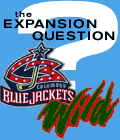 |
| Tuesday, August 8 Different roads in the heartland By Brian A. Shactman ESPN.com |
|||||||||||||||||||||||||||||||||||||||||
|
One thing the Atlanta Thrashers didn't have to worry about last season was the burden of comparison.
That won't be the case with Minnesota and Columbus as the two expansion franchises enter the NHL together in the 2000-01 season. Whenever one club is evaluated, it will be in terms of the other. And the Wild and Blue Jackets already have set up a dynamic for good debate because they are building their teams in distinct ways. Minnesota, a state with a rich and storied hockey tradition, doesn't necessarily have the same short-term pressure as Columbus, which is more of a fringe market where college sports (Ohio State) reign supreme.
Columbus needs to grab fans and keep them, whereas in Minnesota, the window of opportunity is far more open. This distinction is clear with one look at the respective rosters. Minnesota is younger, with more of a lean toward skill. The Blue Jackets are older and, perhaps, grittier. When Columbus is behind, or there's a lull, the Blue Jackets have plenty of guys whose toughness can get the crowd -- and the team -- cranked up a bit. Tyler Wright, Lyle Odelein and Krzysztof Oliwa will make sure of that. The one tough-guy of note for the Wild is Jeff Odgers, 31, and his time as a peak brawler/performer has passed. Steve McKenna, at 6-foot-8 and 125 penalty minutes, is no slouch, though. Then, there's the issue of name recognition. Columbus doesn't exactly have names like Jagr and Messier on the roster, but casual fans will recognize Kevin Dineen, Geoff Sanderson, Ron Tugnutt, Steve Heinze and Wright more than Minnesota's Scott Pellerin, Darby Hendrickson and Jim Dowd -- with Sergei Krivokrasov possibly being the lone exception for the Wild. Obviously, it's not a huge gap, but any identifiable player in Columbus makes it easier for the Jackets fans to relate to the game. It's not as if the fans of Columbus have been in NHL isolation, but it's safe to say there's more of a hockey base in the Minneapolis-St. Paul area than Columbus.
The Wild somewhat offset their more low-key roster by making a few moves catering to the locals, most notably inking home-staters Brian Bonin, Jeff Nielsen and Hendrickson. The way the roster is being built is consistent with the coaching choices as well. Jacques Lemaire might have agitated some hockey traditionalists -- and even changed the game -- by making the neutral-zone trap an NHL mainstay when his stifling system helped the Devils win the Stanley Cup in 1995. But his experience with team defense will make an immediate impact. Lemaire will implement a defensive scheme geared toward keeping the Wild in games. If Minnesota is within a goal entering the third period, the odds are that a few wins will result. In Columbus, Dave King comes in as a respected teacher of the game. He might not be a young guy, but in his days as coach of the Canadian National Team and the Calgary Flames, he maximized talent, getting the most out of everyone and developing young players. With Columbus' combination of well-traveled NHL players and youth, all of King's teaching and patience will be needed; and if he can keep the older guys motivated, he'll be a good foundation-builder for the Blue Jackets. The two contrasting approaches carry inherit risks. If the young talent on Minnesota's roster doesn't develop, the Wild is stuck with very little, although if Manny Fernandez continues to progress as an NHL goalie, things won't ever be too bleak. And in Columbus, a slew of middle-level veteran talent can only go so far, both in appeal and on-ice competition. The Blue Jackets' best hope is that some of the older guys have career years and can be dumped at the trade deadline. If Sanderson scores 25 goals, someone will want him and will give up talent. Same with Tugnutt if Denis proves he's ready to start 60-plus games. Growth: Long term vs. short term. Sounds like a title to a formal stock market investment analysis. But, instead of a percent yield, we'll chart wins and losses over time and see how it's going on Jan. 15, Jan. 17 and April 6 when the two teams meet face-to-face. Brian A. Shactman is the NHL editor for ESPN.com. |
|
||||||||||||||||||||||||||||||||||||||||



